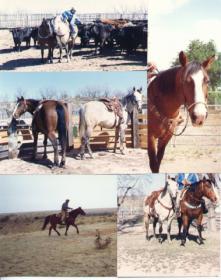Since I mentioned this fact in another thread, which was going way off topic, I thought that I should verify my statement with some references and as a point of interest
Mustangs were captured and sent back to their ancestral beginnings to serve in the Great World Wars, esp World War I
Here is one resource:
By the mid-1800s, the wild horse population had risen to over two million. Then in the latter half of the 19th century, North American wild horse herds began to shrink. Fences and farms cut down the open range of the Great Plains. They were pushed into remote deserts and badlands. The 20th century saw thousands captured for use in first the Boer War and then World War I. Later the feed industries,
Other great resources are two books that I recently read.
One is Mustang, by Deanne Stillman, that I found in a second hand book store.
A very interesting read, as it goes through the entire history of the mustang, from the time their ancestors were brought to North America by the Spanish. While I knew quite a bit of the history of the Conquistadors , I also learned many facts that I was not aware of. The names of some of those original horses are also mentioned
I guess I also never thought of what became of some of those horses, in the days of relying on wind power, when that ship carrying them hit a dead spot, similar to the one mentioned in the poem of The Ancient Mariner’. To un weight the ship, many of those horses walked the gang plank, into the ocean
Details of the Indian wars, the horses that served, and the un regulated way wild horses were rounded up, used for pet food, etc are a disturbing read.
While the number of feral horses need to be regulated, the former methods of creasing, running them to exhaustion using helicopters, are a dark part of history
I also read the book of Wild Horse Annie, a woman that survived childhood polio and became instrumental in laws being passed that were directed towards humane regulations for the protection of wild/feral horses


